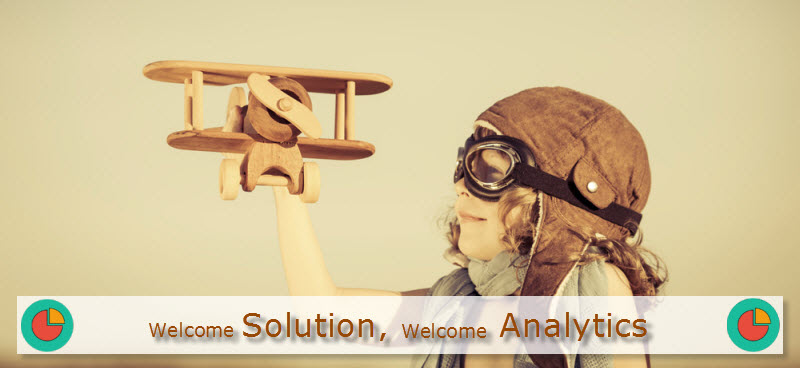
Analytics is everywhere
Yes, Analytics is everywhere and almost each one of us uses it on a different scale, say, deciding on what products to store upcoming festivals being a store owner. Now the analytical tool can be different depending on the scale of the business, considering the example of a small store in a city may not need any sophisticated tool as he can use is reasoning to analyze the historical data. However the story would be different when it comes to a store say “Wal-Mart Stores” or the “The Home Depot”, they have a really huge date to manage on paper of by an individual mind. Here come the sophisticated tools into the game. We can take this as an evolution which was as normal a need base. The need of more and more deep insides make the industry grow rapidly, however, there are many chapters are unfold and scopes of growth of the analytics industry are really bright as we produce a huge data which cannot even imagine, we produce around 3 Quintillion bytes of data every day, this would fill approximate 12 Million Blue-ray disks. The growth rate of the data is phenomenal, as from 100GB per second in the year 2002 to 29 thousand GB per second by beginning of 2014 and estimated to be 50 thousand GB per second by the year 2018. Interestingly, around 90% of the data getting generated every day is UNSTRUCTURED! This gives a great, great scope of analytics, which is becoming a universal truth now.
Big data analytics is playing a key role in many verticals, such as
- E-Commerce
- Travel
- Shopping
- Urban Transport
- Weather forecast
- Healthcare
- Hospitality
- Crime control
- Economic development
- Retail business
- Vouchercloud
- Food and Drinks
- Fuel and power
And the list can go one, these are very common verticals. As we already understand the quantum of the data is so huge that cannot be handled by any human or even a super human, it can and can only be handled by a MACHINE.
Machine learning and big data
Big data analytics in its raw form and it may reduce your operational as well as infrastructure costs, but will not provide you with any additional value for your business over what enterprise data warehouses provides and this is true because of the machine learning of today, that is engaged in big data solutions, has no more ability than the statistical packages that are already in use within enterprise data warehouses solutions. This could be true for today but as we all know nothing last ever, and the future holds a new set of machine learning tools that amalgamate with big data. So let us start with understanding what the neural networks can and cannot do.
Neural network abilities
Let me clear one thing, neural networks cannot think, Yes it cannot think as I or you can. Neural networks have the ability for classification, regression analytics and forecasting and this is all programmed. Let us see some of the applicability of it,
- Marketing and sales
- Fraud detection, regulation compliance, and adherence
- Natural language processing
- Sentiment analysis
- Object and image recognition
- Speech and video recognition
- Medical & radiology diagnosis
- Drug discoveries
- Facial recognition
- Finance trading and long-term investing
- Digital advertising
- Driverless cars
- Remote robots
- Agriculture & environmental conditions
This list can go on and on, but the list is just for understanding the purpose.
It is important to understand that not all neural networks are created equally. Picking a neural network that doesn't align to the specific problem that you are trying to solve will result in poor accuracy and performance.
Programming neural networks
 Neural networks need to be programmed. The process for training a neural network is called “back propagation.” Back propagation takes a lot of time to train a network using conventional CPUs. This is why the neural network community has turned to using graphical processor units, as they are 250 times faster in programming or feeding in data and information or we can say training a neural network. Neural networks work best at identifying patterns. If you were to train a neural network to identify things like wolf, dog, cat and cow, would you be able to see any relationship patterns? Specifically, would neural networks be able to identify patterns that wolf is a wild animal, while the dog, cat, and cow are domesticated? Or that wolf, dog, and cat are carnivorous and the cow is herbivorous? This is a very basic example of what neural is and can do, in reality, it can do wonders.
Neural networks need to be programmed. The process for training a neural network is called “back propagation.” Back propagation takes a lot of time to train a network using conventional CPUs. This is why the neural network community has turned to using graphical processor units, as they are 250 times faster in programming or feeding in data and information or we can say training a neural network. Neural networks work best at identifying patterns. If you were to train a neural network to identify things like wolf, dog, cat and cow, would you be able to see any relationship patterns? Specifically, would neural networks be able to identify patterns that wolf is a wild animal, while the dog, cat, and cow are domesticated? Or that wolf, dog, and cat are carnivorous and the cow is herbivorous? This is a very basic example of what neural is and can do, in reality, it can do wonders.
Extracting comprehension
Here where the ontology come into the game. The ontology will not only help identify all the relevant patterns of relationships to your business concepts, they also provide the means for validating your model and inferring new relationships. As in the above example of grouping the animals into different concepts, it is the relationships that make your data tidy.
In today’s global era, does your company have well-defined business patterns describing how your business concepts are being used? Why the banking industry has co-developed with the Enterprise Data Management Group (EDM), a financial industry business ontology (FIBO)? As this help them in business decisions. Once the business concepts have been generalized to features, then they can use neural networks to go through large amounts of data identifying any potential risk exposures, isn’t this great!
